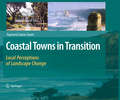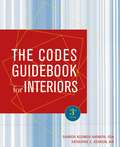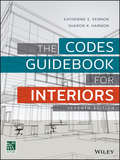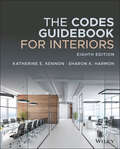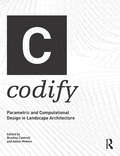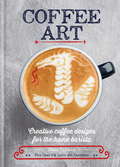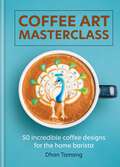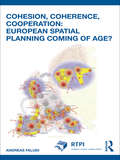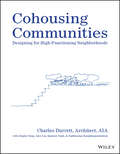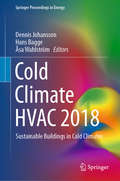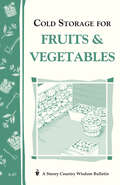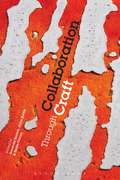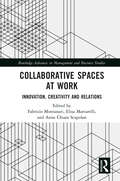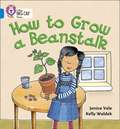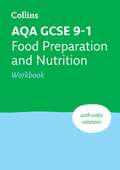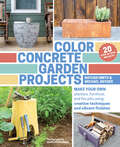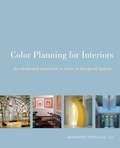- Table View
- List View
Coastal Towns in Transition: Local Perceptions of Landscape Change
by Raymond James GreenMany coastal areas around the world are experiencing dramatic landscape changes as a result of increased tourism development and the "sea change phenomenon" – the migration of affluent urbanites to small coastal towns seeking beautiful, natural surroundings. In response to these changes local residents in these places often complain that the distinctive character of their towns and/or individual neighborhoods is being lost or degraded. Coastal Towns in Transition looks at how changes due to unsympathetic development of the built environment and modification of the natural landscape are perceived to negatively impact on the character of small coastal towns. The book explores the concept of town character, and associated notions of sense of place, genius loci and place identity, as conceptualised by local residents in several coastal town communities along Australia’s Great Ocean Road. Findings of a four-year study involving over 1800 respondents from these communities are used to explore theoretical and methodological issues associated with the assessment of place character in the context of coastal towns that are experiencing rapid environmental change. This book will be of interest to planners and environmental designers, as well as scholars in both landscape studies and social science and planning fields who are interested in the sustainable development of coastal areas. The case studies and associated planning and design strategies, together with the bibliography of selected relevant literature, will provide an invaluable reference for these scholars.
The Codes Guidebook for Interiors
by Sharon K. Harmon Katherine E. KennonNow available in an updated and expanded third edition, The Codes Guidebook for Interiors incorporates the latest standards for interior projects. The book presents the International Building Code, Life Safety Code, NFPA 5000, ICC/ANSI accessibility standard, and many others in a clear, jargon-free style. In addition, you'll find a thorough referencce for the NCIDQ exam or the interior portion of the ARE. Whether you're an architect, interior designer, facilities manager, construction manager, or developer, The Codes Guidebook for Interiors, Third Edition is an indispensable tool of the trade. Order your copy today.
The Codes Guidebook for Interiors: Wiley E-text Folder And Interactive Resource Center Access Card
by Katherine E. Kennon Sharon K. HarmonInterior codes and standards reference of choice for designers and architects, updated and revised Completely revised and updated, the seventh edition of The Codes Guidebook to Interiors is the only book devoted exclusively to codes that are applicable to interior designers. The guide features jargon-free explanations of all the codes and standards that are relevant to designers and architects, including performance codes, building and finish standards, energy codes, and ADA standards. In addition, the dozens of examples and a greatly enhanced with a set of illustrations, including floor plans, that clearly show how codes apply to real-world project. Written by Katherine E. Kennon (a professional architect and facilities planner) and Sharon Koomen Harmon (a professional interior designer and educator) are experts on interior design and architecture codes. Updated coverage contains the most recent ICC codes, including the International Building Code and new material on the ICC International Green Construction Code, as well as the NFPA's most recent Life code. The authors address a wide-variety of building and project types (large and small) and they offer information on single family homes and historical and existing buildings. The seventh edition includes: Easy-to-navigate format geared toward the code process as a whole A step-by-step guide through the codes relevant at each stage in the design process The newest changes to the ADA Standards and ICC/ASI accessibility requirements A companion site that offers interactive checklists, flashcards, PowerPoint lecture slides, and an Instructor's Manual Having all applicable codes in a single resource saves hours of research time, and can dramatically reduce the potential for costly planning oversights. Whether renovation or new construction, small or large, codes apply to every project. The Codes Guidebook for Interiors provides designers with the comprehensive information they need to stay up-to-date.
The Codes Guidebook for Interiors
by Katherine E. Kennon Sharon K. HarmonInterior codes and standards reference of choice for designers and architects, updated and revised Completely revised and updated, the seventh edition of The Codes Guidebook to Interiors is the only book devoted exclusively to codes that are applicable to interior designers. The guide features jargon-free explanations of all the codes and standards that are relevant to designers and architects, including performance codes, building and finish standards, energy codes, and ADA standards. In addition, the dozens of examples and a greatly enhanced with a set of illustrations, including floor plans, that clearly show how codes apply to real-world project. Written by Katherine E. Kennon (a professional architect and facilities planner) and Sharon Koomen Harmon (a professional interior designer and educator) are experts on interior design and architecture codes. Updated coverage contains the most recent ICC codes, including the International Building Code and new material on the ICC International Green Construction Code, as well as the NFPA's most recent Life code. The authors address a wide-variety of building and project types (large and small) and they offer information on single family homes and historical and existing buildings. The seventh edition includes: Easy-to-navigate format geared toward the code process as a whole A step-by-step guide through the codes relevant at each stage in the design process The newest changes to the ADA Standards and ICC/ASI accessibility requirements A companion site that offers interactive checklists, flashcards, PowerPoint lecture slides, and an Instructor's Manual Having all applicable codes in a single resource saves hours of research time, and can dramatically reduce the potential for costly planning oversights. Whether renovation or new construction, small or large, codes apply to every project. The Codes Guidebook for Interiors provides designers with the comprehensive information they need to stay up-to-date.
The Codes Guidebook for Interiors
by Katherine E. Kennon Sharon K. HarmonTHE INTERIOR CODES AND STANDARDS REFERENCE OF CHOICE FOR DESIGNERS AND ARCHITECTS—UPDATED FOR THE 2018 AND 2021 CODES If you are involved with the design or management of buildings and spaces, it is important to remain up-to-date on the ever-evolving codes and standards that keep communities safe. With over 80,000 copies sold, The Codes Guidebook for Interiors continues to provide comprehensive explanations of the major codes and standards applicable to commercial and residential interior projects. The easily navigable format gives clear perspective to how these often confusing concepts and requirements are integrated into real world practice, helping designers incorporate the relevant standards into their projects. Updated with the most recent changes and insights to the codes and standards of the ICC, NFPA, ANSI, ADA, and other standards, the Eighth Edition provides unparalleled and integrated guidance on building safety, accessibility, sustainability, energy efficiency, and more. Updates to the Eighth Edition include: Explanations of code requirements, highlighting the latest changes in the 2018 and 2021 ICC codes, including the International Building Code and the NFPA’s Life Safety Code Clarifications to how and when the ADA, ABA and the ICC/ANSI accessibility requirements will apply to a project Introduction to the codes and standards that address sustainability in typical projects In-depth examinations of fire and smoke resistant assemblies, fire protection systems, and plumbing and mechanical requirements A companion website with printable study flashcards, instructor’s manual, and PowerPoint slides for use in academic settings Digital and printable code checklists that can guide code research for professional projects and use in a design studio Current, practical, and relevant to nearly any interior or architectural project, The Codes Guidebook for Interiors provides invaluable insight and reference for both student and professional interior designers and architects.
The Codes Guidebook for Interiors
by Katherine E. Kennon Sharon K. HarmonTHE INTERIOR CODES AND STANDARDS REFERENCE OF CHOICE FOR DESIGNERS AND ARCHITECTS—UPDATED FOR THE 2018 AND 2021 CODES If you are involved with the design or management of buildings and spaces, it is important to remain up-to-date on the ever-evolving codes and standards that keep communities safe. With over 80,000 copies sold, The Codes Guidebook for Interiors continues to provide comprehensive explanations of the major codes and standards applicable to commercial and residential interior projects. The easily navigable format gives clear perspective to how these often confusing concepts and requirements are integrated into real world practice, helping designers incorporate the relevant standards into their projects. Updated with the most recent changes and insights to the codes and standards of the ICC, NFPA, ANSI, ADA, and other standards, the Eighth Edition provides unparalleled and integrated guidance on building safety, accessibility, sustainability, energy efficiency, and more. Updates to the Eighth Edition include: Explanations of code requirements, highlighting the latest changes in the 2018 and 2021 ICC codes, including the International Building Code and the NFPA’s Life Safety Code Clarifications to how and when the ADA, ABA and the ICC/ANSI accessibility requirements will apply to a project Introduction to the codes and standards that address sustainability in typical projects In-depth examinations of fire and smoke resistant assemblies, fire protection systems, and plumbing and mechanical requirements A companion website with printable study flashcards, instructor’s manual, and PowerPoint slides for use in academic settings Digital and printable code checklists that can guide code research for professional projects and use in a design studio Current, practical, and relevant to nearly any interior or architectural project, The Codes Guidebook for Interiors provides invaluable insight and reference for both student and professional interior designers and architects.
Codify: Parametric and Computational Design in Landscape Architecture
by Bradley Cantrell Adam MekiesCodify: Parametric and Computational Design in Landscape Architecture provides a series of essays that explore what it means to use, modify and create computational tools in a contemporary design environment. Landscape architecture has a long history of innovation in the areas of computation and media, particularly in how the discipline represents, analyses, and constructs complex systems. This curated volume spans academic and professional projects to form a snapshot of digital practices that aim to show how computation is a tool that goes beyond methods of representation and media. The book is organized in four sections; syntax, perception, employ, and prospective. The essays are written by leading academics and professionals and the sections examine the role of computational tools in landscape architecture through case studies, historical accounts, theoretical arguments, and nascent propositions.
Codify: Parametric and Computational Design in Landscape Architecture
by Bradley Cantrell Adam MekiesCodify: Parametric and Computational Design in Landscape Architecture provides a series of essays that explore what it means to use, modify and create computational tools in a contemporary design environment. Landscape architecture has a long history of innovation in the areas of computation and media, particularly in how the discipline represents, analyses, and constructs complex systems. This curated volume spans academic and professional projects to form a snapshot of digital practices that aim to show how computation is a tool that goes beyond methods of representation and media. The book is organized in four sections; syntax, perception, employ, and prospective. The essays are written by leading academics and professionals and the sections examine the role of computational tools in landscape architecture through case studies, historical accounts, theoretical arguments, and nascent propositions.
Coffee Art: Creative Coffee Designs for the Home Barista
by Dhan TamangOver 128 pages of 60 stunning designs from Britain's champion latte artist. From free pouring to etching, stencilling and more complicated designs for the black belt barista, you'll have fun emulating innovative designs such as The Swan, The Unicorn, and frothy 3-D babyccino animals. The book even includes 9 stencil patterns for you to trace and try.Starting with basic skills and patterns, readers will learn how to create the crema (the froth that acts as a canvas in the coffee cup) and how to produce the hearts, rosettas and tulips that will be used as the basis to form more complicated artworks. Dhan Tamang is a world-renowned latte artist particularly known for his use of colour, and now you too can create impressive multicoloured designs following Dhan's step-by-step instructions. By the end of this book you will be able to create fabulous designs to delight family members and dinner party guests alike.
Coffee Art Masterclass: 50 incredible coffee designs for the home barista
by Dhan TamangTake your coffee art to the next level with 50 spectacular-yet-simple latte art designs to impress family and friends. From the comfort of your own kitchen you can recreate great paintings, pour and etch stunning natural wonders, iconic buildings and fantastical creatures. No special equipment is needed and once you've mastered the basics a world of incredible coffee art awaits you.Coffee Art Masterclass includes next-level latte designs that everyone can achieve.
Cohesion, Coherence, Cooperation: European Spatial Planning Coming of Age? (RTPI Library Series)
by Andreas FaludiSince its foundation the European Union has gradually developed policies that are aimed at achieving increased economic and social cohesion. This book examines the most recent of these, the concept of territorial cohesion. Territorial cohesion is the pursuit of balanced development, competitiveness, sustainable development, and good governance. These concerns are most readily addressed by the formulation of spatial strategies under the umbrella of spatial planning, that brings together a multitude of public and private actors in a process that requires cohesion, coherence and co-operation. This book traces the development of spatial planning at European level and argues that spatial planning can become a vehicle, not only for territorial cohesion, but for EU policy generally.
Cohesion, Coherence, Cooperation: European Spatial Planning Coming of Age? (RTPI Library Series)
by Andreas FaludiSince its foundation the European Union has gradually developed policies that are aimed at achieving increased economic and social cohesion. This book examines the most recent of these, the concept of territorial cohesion. Territorial cohesion is the pursuit of balanced development, competitiveness, sustainable development, and good governance. These concerns are most readily addressed by the formulation of spatial strategies under the umbrella of spatial planning, that brings together a multitude of public and private actors in a process that requires cohesion, coherence and co-operation. This book traces the development of spatial planning at European level and argues that spatial planning can become a vehicle, not only for territorial cohesion, but for EU policy generally.
Cohousing Communities: Designing for High-Functioning Neighborhoods
by Charles DurrettCohousing Communities Explore a groundbreaking and holistic new approach to designing community-first neighborhoods In Cohousing Communities: Designing for High-Functioning Neighborhoods, distinguished architect and affordable housing advocate Charles Durrett delivers a complete, start-to-finish guide for designing anything where the emphasis lies with the community. This book describes the consequential role that architecture and a healthy design process can play in the success of neighborhoods, churches, towns, and more. It’s an inspiring collection of ideas that prioritize high-functioning neighborhoods. In the book, the author draws on the success of hundreds of community-first projects to show readers how to design a project that addresses both timeless and modern challenges—from aging to climate change and racism—in its architecture and urban design. He compiles facts and concepts that are essential to the design of a high-functioning community, where people can participate in a way that reflects their values, improves their social connections, and retain their autonomy and privacy. Readers will also find: Ideas for town planning, street planning, and other town altering improvements Discussions of how developers can make better multifamily housing Explorations of how planners and politicians can make high-functioning neighborhoods a cornerstone of their community In-depth treatments of families who want to confirm that they’re choosing the right neighborhood Perfect for university students and professors who strive to see new ways to create neighborhoods, Cohousing Communities: Designing for High-Functioning Neighborhoods will also appeal to universities planning new neighborhoods for retired alumni or new housing for students and faculty.
Cohousing Communities: Designing for High-Functioning Neighborhoods
by Charles DurrettCohousing Communities Explore a groundbreaking and holistic new approach to designing community-first neighborhoods In Cohousing Communities: Designing for High-Functioning Neighborhoods, distinguished architect and affordable housing advocate Charles Durrett delivers a complete, start-to-finish guide for designing anything where the emphasis lies with the community. This book describes the consequential role that architecture and a healthy design process can play in the success of neighborhoods, churches, towns, and more. It’s an inspiring collection of ideas that prioritize high-functioning neighborhoods. In the book, the author draws on the success of hundreds of community-first projects to show readers how to design a project that addresses both timeless and modern challenges—from aging to climate change and racism—in its architecture and urban design. He compiles facts and concepts that are essential to the design of a high-functioning community, where people can participate in a way that reflects their values, improves their social connections, and retain their autonomy and privacy. Readers will also find: Ideas for town planning, street planning, and other town altering improvements Discussions of how developers can make better multifamily housing Explorations of how planners and politicians can make high-functioning neighborhoods a cornerstone of their community In-depth treatments of families who want to confirm that they’re choosing the right neighborhood Perfect for university students and professors who strive to see new ways to create neighborhoods, Cohousing Communities: Designing for High-Functioning Neighborhoods will also appeal to universities planning new neighborhoods for retired alumni or new housing for students and faculty.
Cold Climate HVAC 2018: Sustainable Buildings In Cold Climates (Springer Proceedings in Energy)
by Dennis Johansson Hans Bagge Åsa WahlströmThis volume presents the proceedings of the 9th Cold Climate HVAC conference, which was held in Kiruna, Sweden in 2018. The conference highlighted key technologies and processes that allow scientists, designers, engineers, manufacturers and other decision makers in cold climate regions to achieve good indoor environmental quality (IEQ) with a minimum use of energy and other resources. The conference addressed various technical, economic and social aspects of buildings and HVAC systems in new and renovated buildings. This proceedings volume gathers peer-reviewed papers by a diverse and international range of authors and showcases perspectives and practices in cold climate building design from around the globe. The following major aspects, which include both fundamental and theoretical research as well as applications and case studies, are covered: (1) Energy and power efficiency and low-energy buildings; (2) Renovating buildings; (3) Efficient HVAC components; (4) Heat pumps and geothermal systems; (5) Municipal and city energy systems; (6) Construction management; (7) Buildings in operation; (8) Building simulation; (9) Reference data; (10) Transdisciplinary connections and social aspects; (11) Indoor environments and health; (12) Moisture safety and water damage; (13) Codes, regulations, standards and policies; and (14) Other aspects of buildings in cold climates.
Cold Storage for Fruits & Vegetables: Storey Country Wisdom Bulletin A-87 (Storey Country Wisdom Bulletin)
by John Storey Martha StoreySince 1973, Storey's Country Wisdom Bulletins have offered practical, hands-on instructions designed to help readers master dozens of country living skills quickly and easily. There are now more than 170 titles in this series, and their remarkable popularity reflects the common desire of country and city dwellers alike to cultivate personal independence in everyday life.
Collaboration Through Craft
by Amanda Ravetz Alice Kettle Helen FelceyOffering a challenging new argument for the collaborative power of craft, this ground-breaking volume analyses the philosophies, politics and practicalities of collaborative craft work. The book is accessibly organised into four sections covering the cooperation and compromises required by the collaborative process; the potential of recent technological advances for the field of craft; the implications of cross-disciplinary and cross-cultural collaborations for authority and ownership; and the impact of crafted collaborations on the institutions where we work, learn and teach. With cutting-edge essays by established makers and artists such as Allison Smith (US) and Brass Art (UK), curator Lesley Millar, textile designer Trish Belford and distinguished thinker Glenn Adamson, Collaborating Through Craft will be essential reading for students, artists, makers, curators and scholars across a number of fields.
Collaboration Through Craft
by Amanda Ravetz Alice Kettle Helen FelceyOffering a challenging new argument for the collaborative power of craft, this ground-breaking volume analyses the philosophies, politics and practicalities of collaborative craft work. The book is accessibly organised into four sections covering the cooperation and compromises required by the collaborative process; the potential of recent technological advances for the field of craft; the implications of cross-disciplinary and cross-cultural collaborations for authority and ownership; and the impact of crafted collaborations on the institutions where we work, learn and teach. With cutting-edge essays by established makers and artists such as Allison Smith (US) and Brass Art (UK), curator Lesley Millar, textile designer Trish Belford and distinguished thinker Glenn Adamson, Collaborating Through Craft will be essential reading for students, artists, makers, curators and scholars across a number of fields.
Collaborative Spaces at Work: Innovation, Creativity and Relations (Routledge Advances in Management and Business Studies)
by Fabrizio Montanari Elisa Mattarelli Anna Chiara ScapolanCollaborative spaces are more than physical locations of work and production. They present strong identities centered on collaboration, exchange, sense of community, and co-creation, which are expected to create a physical and social atmosphere that facilitates positive social interaction, knowledge sharing, and information exchange. This book explores the complex experiences and social dynamics that emerge within and between collaborative spaces and how they impact, sometimes unexpectedly, on creativity and innovation. Collaborative Spaces at Work is timely and relevant: it will address the gap in critical understandings of the role and outcomes of collaborative spaces. Advancing the debate beyond regional development rhetoric, the book will investigate, through various empirical studies, if and how collaborative spaces do actually support innovation and the generation of new ideas, products, and processes. The book is intended as a primary reference in creativity and innovation, workspaces, knowledge and creative workers, and urban studies. Given its short chapters and strong empirical orientation, it will also appeal to policy makers interested in urban regeneration, sustaining innovation, and social and economic development, and to managers of both collaborative spaces and companies who want to foster creativity within larger organizations. It can also serve as a textbook in master’s degrees and PhD courses on innovation and creativity, public management, urban studies, management of work, and labor relations.
Collaborative Spaces at Work: Innovation, Creativity and Relations (Routledge Advances in Management and Business Studies)
by Fabrizio Montanari Elisa Mattarelli Anna Chiara ScapolanCollaborative spaces are more than physical locations of work and production. They present strong identities centered on collaboration, exchange, sense of community, and co-creation, which are expected to create a physical and social atmosphere that facilitates positive social interaction, knowledge sharing, and information exchange. This book explores the complex experiences and social dynamics that emerge within and between collaborative spaces and how they impact, sometimes unexpectedly, on creativity and innovation. Collaborative Spaces at Work is timely and relevant: it will address the gap in critical understandings of the role and outcomes of collaborative spaces. Advancing the debate beyond regional development rhetoric, the book will investigate, through various empirical studies, if and how collaborative spaces do actually support innovation and the generation of new ideas, products, and processes. The book is intended as a primary reference in creativity and innovation, workspaces, knowledge and creative workers, and urban studies. Given its short chapters and strong empirical orientation, it will also appeal to policy makers interested in urban regeneration, sustaining innovation, and social and economic development, and to managers of both collaborative spaces and companies who want to foster creativity within larger organizations. It can also serve as a textbook in master’s degrees and PhD courses on innovation and creativity, public management, urban studies, management of work, and labor relations.
Collins Big Cat Phonics — How to Grow a Beanstalk: Band 04/Blue (PDF) (Collins Big Cat Phonics Ser. (PDF))
by Janice Vale Kelly Waldek Collins Big Cat StaffDo you know how to turn a small, fat thing into a long, thin thing? It’s easy – just take a bean and grow a beanstalk! This simple instruction text shows you exactly how to do it. • Blue / Band 4 - A simple instruction text • Text type - Non-fiction • The focus phonemes in this book are ur (curl), al and ow (how). • The flow chart on the final spread gives children the chance to recap and discuss the different stages of the process. • Janice Vale also wrote Yellow 3 Rock Out. • This book has been levelled for Reading Recovery.
Collins GCSE Grade 9-1 Revision — AQA GCSE 9-1 FOOD PREPARATION & NUTRITION COMPLETE REVISION & PRACTICE: Ideal For Home Learning, 2023 And 2024 Exams
by Collins Gcse Fiona Balding Kath Callaghan Suzanne Gray Barbara Monks Barbara Rathmill Louise T DaviesCollins GCSE Grade 9-1 Revision — AQA GCSE 9-1 FOOD PREPARATION & NUTRITION WORKBOOK: Ideal For Home Learning, 2023 And 2024 Exams
by Fiona Balding Kath Callaghan Suzanne Gray Barbara Monks Barbara Rathmill Louise T Davies Collins GcseColor Concrete Garden Projects: Make Your Own Planters, Furniture, and Fire Pits Using Creative Techniques and Vibrant Finishes
by Nathan Smith Michael SnyderConcrete artisans Nathan Smith and Michael Snyder offer easy-to-follow directions for creating colorful concrete garden furniture and plant containers that are functional and stylish.
Color Planning for Interiors: An Integrated Approach to Color in Designed Spaces
by Margaret PortilloEvidence-based approach to color planning lets you discover the impact of color on people and space. You'll learn to systematically develop innovative, holistic color solutions in interior design with this book's evidence-based approach to color planning. The author sets forth a color planning framework that integrates multiple criteria, enabling you to fully consider the complex role that color plays in interior design. Color Planning for Interiors is based on the findings from a national study that the author conducted, which identified five categories of color criteria: Color as Composition Color Preferences Color as Communication Color Pragmatics Color for Engagement The author interviewed noted designers and colorists about the projects that best represented their approach to color. As a result, you'll discover how leaders in the field examine color from compositional, symbolic, behavioral, preferential, and pragmatic perspectives in order to arrive at a carefully considered solution. Moreover, you'll see how designers and architects apply this knowledge to a broad range of interior spaces, including workplaces, restaurants, retail settings, healthcare facilities, and private residences. Complementing theory and research, real-life examples are presented from interior design projects that consider color in relation to light, materiality, and interior architecture. In addition, full-color diagrams, photographs, and design renderings illustrate concepts throughout the book to help you understand how to select and work with color. From the fundamental principles of color theory to innovative applications, all aspects of designing interiors with color are examined, making this book ideal for all professionals and students in interior design who want to develop the full potential of their color palettes.
